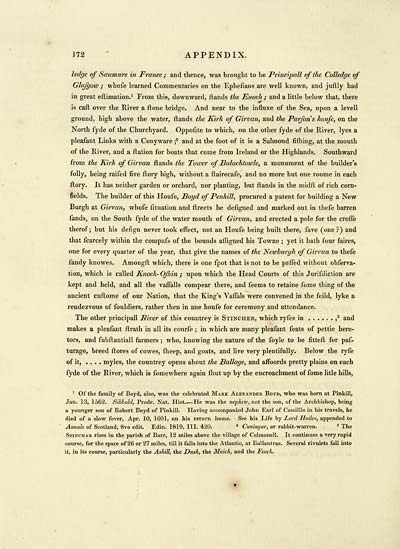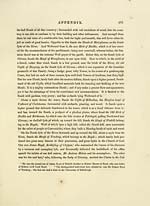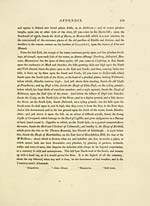Download files
Complete book:
Individual page:
Thumbnail gallery: Grid view | List view

172 APPENDIX.
ledge of Saumure in France; and thence, was brought to be Principall of the Colledge of
Glqfgow ; whofe learned Commentaries on the Ephefians are well known, and juftly had
in great estimation. 1 From this, downward, ftands the Enoch ; and a little below that, there
is caft over the River a Hone bridge. And near to the influxe of the Sea, upon a levell
ground, high above the water, ftands the Kirk of Girvan, and the Par/on s hoafe, on the
North fyde of the Churchyard. Oppofite to which, on the other fyde of the River, lyes a
pleafant Links with a Conytvare ; 2 and at the foot of it is a Salraond filhing, at the mouth
of the River, and a ftation for boats that come from Ireland or the Highlands. Southward
from the Kirk of Girvan ftands the Tower of Balachtowle, a monument of the builder's
folly, being railed five ftory high, without a ftairecafe, and no more but one roome in each
ftory. It has neither garden or orchard, nor planting, but ftands in the midft of rich coin-
fields. The builder of this Houfe, Boyd of Penkill, procured a patent for building a New
Burgh at Girvan, whofe Situation and ftreets he defigned and marked out in thefe barren
fands, on the South fyde of the water mouth of Girvan, and erected a pole for the crofle
therof ; but his defign never took effect, not an Houfe being built there, fave (one ?) and
that fcarcely within the compafs of the hounds affigned his Towne ; yet it hath four faires,
one for every quarter of the year, that give the names of the Newlurgh of Girvan to thefe
fandy knowes. Amongft which, there is one fpot that is not to be paffed without obferva-
tion, which is called Knock- Ofliin ; upon which the Head Courts of this Jurifdiction are
kept and held, and all the vaffalls compear there, and feems to retaine fome thing of the
aucient cuftome of our Nation, that the King's Vaftals were convened in the feild, lyke a
rendezvous of fouldiers, rather then in ane houfe for ceremony and attendance.
The other principall River of this countrey is Stincher, which ryfes in , s and
makes a pleafant ftrath in all its courfe ; in which are many pleafant feats of pettie here-
tors, and fubftantiall farmers ; who, knowing the nature of the foyle to be fitteft for paf-
turage, breed ftores of cowes, lheep, and goats, and live very plentifully. Below the ryfe
of it, .... myles, the countrey opens about the Ballage, and affoords pretty plains on each
fyde of the River, which is fomewhere again ihut up by the encroachment of fome litle hills,
' Of the family of Boyd, also, was the celebrated Mark Alexander Boyd, who was born at Pinkill,
Jan. 13, 1562. Sibbald, Prodr. Nat. Hist. — He was the nephew, not the son, of the Archbishop, being
a younger son of Robert Boyd of Pinkill. Having accompanied John Earl of Cassillis in his travels, he
died of a slow fever, Apr. 10, 1601, on his return home. See his Life by Lord Hailes, appended to
Annals of Scotland, 8vo edit. Edin. 1819, III. 420. * Cuninyar, or rabbit-warren. 3 The
Stinchar rises in the parish of Barr, 12 miles above the village of Colmonell. It continues a very rapid
course, for the space of 26 or 27 miles, till it falls into the Atlantic, at Ballantrae. Several rivulets fall into
it, in its course, particularly the AsldU, the Dusk, the Muick, and the Feoeh.
ledge of Saumure in France; and thence, was brought to be Principall of the Colledge of
Glqfgow ; whofe learned Commentaries on the Ephefians are well known, and juftly had
in great estimation. 1 From this, downward, ftands the Enoch ; and a little below that, there
is caft over the River a Hone bridge. And near to the influxe of the Sea, upon a levell
ground, high above the water, ftands the Kirk of Girvan, and the Par/on s hoafe, on the
North fyde of the Churchyard. Oppofite to which, on the other fyde of the River, lyes a
pleafant Links with a Conytvare ; 2 and at the foot of it is a Salraond filhing, at the mouth
of the River, and a ftation for boats that come from Ireland or the Highlands. Southward
from the Kirk of Girvan ftands the Tower of Balachtowle, a monument of the builder's
folly, being railed five ftory high, without a ftairecafe, and no more but one roome in each
ftory. It has neither garden or orchard, nor planting, but ftands in the midft of rich coin-
fields. The builder of this Houfe, Boyd of Penkill, procured a patent for building a New
Burgh at Girvan, whofe Situation and ftreets he defigned and marked out in thefe barren
fands, on the South fyde of the water mouth of Girvan, and erected a pole for the crofle
therof ; but his defign never took effect, not an Houfe being built there, fave (one ?) and
that fcarcely within the compafs of the hounds affigned his Towne ; yet it hath four faires,
one for every quarter of the year, that give the names of the Newlurgh of Girvan to thefe
fandy knowes. Amongft which, there is one fpot that is not to be paffed without obferva-
tion, which is called Knock- Ofliin ; upon which the Head Courts of this Jurifdiction are
kept and held, and all the vaffalls compear there, and feems to retaine fome thing of the
aucient cuftome of our Nation, that the King's Vaftals were convened in the feild, lyke a
rendezvous of fouldiers, rather then in ane houfe for ceremony and attendance.
The other principall River of this countrey is Stincher, which ryfes in , s and
makes a pleafant ftrath in all its courfe ; in which are many pleafant feats of pettie here-
tors, and fubftantiall farmers ; who, knowing the nature of the foyle to be fitteft for paf-
turage, breed ftores of cowes, lheep, and goats, and live very plentifully. Below the ryfe
of it, .... myles, the countrey opens about the Ballage, and affoords pretty plains on each
fyde of the River, which is fomewhere again ihut up by the encroachment of fome litle hills,
' Of the family of Boyd, also, was the celebrated Mark Alexander Boyd, who was born at Pinkill,
Jan. 13, 1562. Sibbald, Prodr. Nat. Hist. — He was the nephew, not the son, of the Archbishop, being
a younger son of Robert Boyd of Pinkill. Having accompanied John Earl of Cassillis in his travels, he
died of a slow fever, Apr. 10, 1601, on his return home. See his Life by Lord Hailes, appended to
Annals of Scotland, 8vo edit. Edin. 1819, III. 420. * Cuninyar, or rabbit-warren. 3 The
Stinchar rises in the parish of Barr, 12 miles above the village of Colmonell. It continues a very rapid
course, for the space of 26 or 27 miles, till it falls into the Atlantic, at Ballantrae. Several rivulets fall into
it, in its course, particularly the AsldU, the Dusk, the Muick, and the Feoeh.
Set display mode to:
![]() Universal Viewer |
Universal Viewer | ![]() Mirador |
Large image | Transcription
Mirador |
Large image | Transcription
Images and transcriptions on this page, including medium image downloads, may be used under the Creative Commons Attribution 4.0 International Licence unless otherwise stated. ![]()
| Histories of Scottish families > Historical and genealogical account of the principal families of the name of Kennedy > (194) Page 172 |
|---|
| Permanent URL | https://digital.nls.uk/94894258 |
|---|
| Description | A selection of almost 400 printed items relating to the history of Scottish families, mostly dating from the 19th and early 20th centuries. Includes memoirs, genealogies and clan histories, with a few produced by emigrant families. The earliest family history goes back to AD 916. |
|---|

